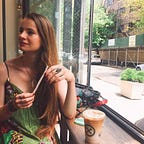Reflection on Design-Thinking Group Activity -Wednesday
Themes: Tactical Urbanism, Randyland, Park(ing) Day, Green spaces, community, hiking trails, nature’s power, ecosystems, natural parks, “feeling,” bonding w/nature, “communal,” vibrant, creative, policy
Background: I was in the group that decided to tackle the question of Tactical Urbanism, which focuses on spaces of land, that are limited to certain activities, and have restricted access for the public. One specific example was parking lots, and individuals, who would bring their own lawn pieces, grass and would occupy a lot, to show that there was another use for it aside a concrete lot. (Projects similar to these may have motivated, the city of NY to turn into a pedestrian area permanently.)Our project discovery was oriented on making city spaces more natural, and open for community and individuals activities. We were thinking in the context of food trucks, street festivals, park(ing) day, and activism surrounding spaces that had restricted use.
Implementation: Our team looked into a variety of different activities, that communities took part in, including nature exploration like hiking. We brainstormed different approaches in how to make certain cities, which lack social places/spaces to sit/ more open to the public use for relaxation and enjoying the city atmosphere. We looked at the project from the perspective ranging from an individual activist to a large community of activists, in seeing how change could be brought from their position and skills. We made sure to consider multiple sides that would be involved in the implementation, including local government, citizens, and companies in the region. We wanted to give the locals of the area a greater voice because it was not received or heard by the government
Implementation: We ended on some potential speculations, but here was one example of one of our many approaches. We thought of utilizing “Meet-Up” and other social apps to organize movements of tactical urbanism in areas of cities that really need it like, Pittsburgh’s downtown area, and then having people occupy spaces that were not in use, aka, wasted space. Through this individuals would be able to understand the movement enough, to be able to spread it to other communities, and also support movements similar to it.
Works Cited (Excuse the long list).
